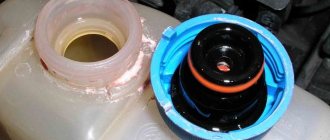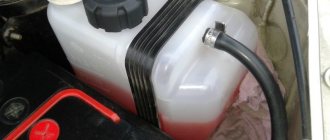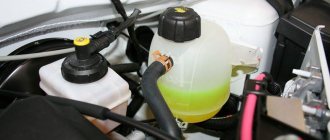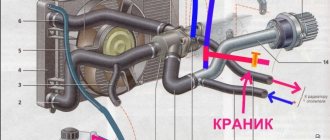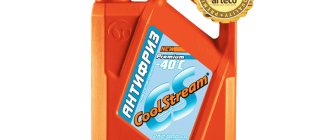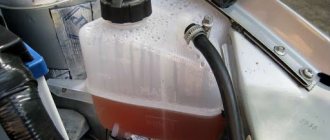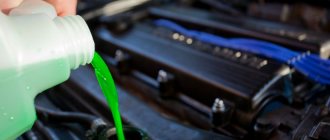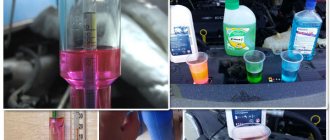Over time, the additives included in antifreeze lose their properties. Because of this, a characteristic sediment appears in the cooling system, which changes the color and consistency of the liquid.
Oil getting into the antifreeze can be judged by an unpleasant burnt smell. The more lubricating fluid in the refrigerant, the stronger and more unpleasant the mixture smells. It is no longer able to properly cool the engine, so the power unit often overheats.
After draining such an emulsion, the system is washed to completely remove oil inclusions. However, if you do not clean the expansion tank, the remains of the old antifreeze still end up in the new refrigerant.
Experienced car owners often add a small amount of citric acid to the cooling system reservoir, which helps prevent the formation of rust and remove existing deposits.
Next, we will look at the procedure for flushing the tank in more detail, and we will name the main means for removing antifreeze and emulsion residues from it.
Why did the antifreeze in the car turn dark?
Causes of coolant blackening The most likely reason is that the antifreeze has expired. Basically, the service life is approximately 50 thousand kilometers. When this limit is reached, the refrigerant begins to lose its properties and must be replaced.
Interesting materials:
What is debug mode when connecting USB? What is RNM on a cash receipt? What is parental Saturday in Orthodoxy? What is Rosa Khutor? What is RPO in a Russian Post receipt? What is the Romanian Deadlift? What is rust from a chemical point of view? What is a garden plot? What is the closing balance? What are plumbing fixtures?
Causes and consequences of oil getting into the cooling system
Lubrication and cooling systems are critical components that directly affect engine performance. In a working car, the circuits through which oil and antifreeze circulate are sealed against each other and the liquids should not interact in any way, much less mix.
If suddenly the presence of oil is detected in the expansion tank, then it is necessary to urgently carry out diagnostics and identify the cause of the incident. As a rule, lubricant can enter the cooling system circuit due to two malfunctions:
- Violation of the tightness between the head and the cylinder block due to loosening of the fastening bolts, violation of the integrity of the gasket between them, changes in the plane of the head or microcracks in the cylinder block. As a rule, these malfunctions occur due to engine overheating.
- On diesel engines - due to a leak in the oil cooler.
In any case, if signs of the presence of oil in the coolant are detected, competent vehicle diagnostics and repairs are necessary. After the cause of mixing fluids has been found and eliminated, the remaining oil must be removed from the cooling system.
The fact is that an aggressive environment with high acidity, which occurs when mixing antifreeze and oil, will quickly corrode plastic and rubber parts (pipes, gaskets, seals), as well as contribute to the formation of pockets of corrosion and its development on metal parts. Oil can also form into clumps and clog the channels in the cooling jacket of the cylinder block.
Application of citric acid
Experienced car owners are well aware of the fact that the basis of all such cooling system cleaning products is citric acid. Why pay several thousand rubles and buy such cleaning liquids, if you can literally buy a small amount of lemon juice in the nearest store for 100 rubles and use it to clean the entire cooling system. The direct use of such improvised folk remedies is not particularly difficult, which allows you to significantly save on the operation of the car, and anyone, even a novice car owner, can carry out the necessary service.
If there is noticeable overheating in the car, the engine begins to run unevenly, then it is quite possible that it is time to clean the cooling system. The easiest way to do this work is on an overpass or in a garage pit, which will allow you to easily drain the old antifreeze. All you need is a small amount of citric acid and distilled water. It is necessary to add lemon juice to distilled water at the rate of 100 grams of chemical per 10 liters of water. The solution is thoroughly mixed and poured into the cooling system with drained antifreeze.
All that remains is to start the engine, warm up the engine to 90 degrees, this will allow all the liquid to be distributed throughout the system, then turn off the engine and leave the car for several hours. During this time, citric acid dissolves existing dense deposits, after which the liquid is drained, which after this procedure may have a rusty or black color.
The car owner will only have to pour new antifreeze into the system and bleed the pipes to get rid of air jams. The engine is started, checking the performance of the entire system, the engine must be properly cooled, and antifreeze must circulate first through the small and then through the large circuit. By doing this work yourself, you can solve all problems with the functioning of the cooling system for two to three years, and the engine will work correctly. At the same time, the car owner will avoid problems with engine overheating and possible serious breakdowns only due to the operation of the power unit at high temperatures.
How to flush the expansion tank?
- Overheat. The most popular reason. Even with short-term overheating, the geometry of the block head is disrupted. Only cast iron cylinder heads do not “drive”, but they are no longer left in the modern world.
- Poor quality engine assembly after repair. Alas, not every mechanic knows how to tighten cylinder head bolts to the correct torque. When contacting the service, pay attention to this. Experienced mechanics always use a torque wrench and know the tightening technology.
- Gasket defect. How long a cheap substitute will last is a matter of luck. But as a rule, no more than 30 thousand kilometers. In the worst cases, the car doesn't even make it to the garage. Don't skimp on spare parts. Even the most expensive gasket will cost less than reassembling and disassembling the cylinder head, not to mention the lost time.
One of the reasons for increased pressure in the cooling system is a malfunction of the valve in the cap of the expansion tank: it simply jams (sours). As a rule, the valve is not repairable and must be replaced. Although there are car owners who use carburetor cleaning fluids to remove all deposits and return the part to functionality.
How to clean the expansion tank from rust
Internal cleaning is recommended at least once a year. It is best to do this after winter is over. A light indicator with a picture of a radiator helps determine the exact time. In addition, there are other signs by which one can judge the need for cleansing.
Systematic engine overheating and failures when starting it.
Additional tips and tricks
In order for the expansion tank repair to be successful, you should follow these recommendations:
- It is best to solder the damaged area;
- Brass mesh is used as a reinforcing layer - aluminum material will not be suitable in this case;
- It is recommended to sand the connecting seam, putty, coat with primer and paint.
The breakdown of the expansion tank is considered an unpleasant violation. To repair damage, it is recommended to use a soldering iron. As a temporary measure, it is permissible to use reliable adhesives. Two-component substances are considered a suitable option.
About malfunctions and tank repairs
During operation of the machine, the following breakdowns of the expansion tank may occur;
- contamination or failure of the bypass valve of the plug;
- rupture of the tank body;
- Antifreeze leaking from under the cap.
Most car enthusiasts, when a valve or body breaks down, simply replace the part with a new one. This is justified by the lack of time for repairs and the low cost of these spare parts. Although, if desired, the burst plastic of the tank can be soldered, and the lid can be disassembled and cleaned.
Leaks from under the cork occur when the seal is not tight or due to the design features of the container. For example, on VAZ 2110 cars, a stream from the upper small fitting connected to the radiator hits directly into the neck, causing a leak. The solution is to install a more advanced tank from Priora.
Video: tank body repair
A car's expansion tank is considered one of the most reliable parts. They often last the entire life of the car, especially on foreign cars. To avoid having to change the container ahead of time, it is recommended to periodically check the condition of the valve in the lid. If it is in order, then the plastic of the vessel will not burst from high pressure.
Home →
Maintenance and Repair → Repair →
Flushing the cooling system from engine oil
A situation often arises when the driver does not know how to flush the engine cooling system of oil. The problem is not complicated, but if you do not follow the recommendations, do not adhere to the instructions, or choose non-working cleaning methods, the car owner will only waste time and money.
Cooling system flush frequency
There are no clear rules written down anywhere. But you need to take into account that in a working car - a car, a truck, mixing of oil and antifreeze does not occur - the 2 fluids are sealed and function separately.
But sometimes oil gets into the cooling system (it’s a breakdown or the owner accidentally filled it in - it doesn’t matter) and you need to urgently take the necessary actions to fix the problem. If ignored, the situation will lead to the following consequences:
- wear of bearings, since parts are negatively affected by an aggressive environment;
- risk of diesel engine jamming, water penetrates the cylinders and causes water hammer;
- contamination of the main line and pipes of the cooling system, as a result of which the latter ceases to function.
Non-working cleaning methods
When faced with the problem of oil getting into the car’s cooling system, drivers at home resort to different cleaning methods. But not all options are effective.
For example, they clean with “Whiteness”. But few people know that the product contains chlorine, which causes corrosion of aluminum components (and the radiator of most cars is made of this metal). In addition, “Whiteness” is not capable of properly cleaning the system, but will only cause damage.
Another option is baking soda. It effectively removes rust and scale deposits, but cannot fight oily deposits.
Operating principle of the expansion tank cap
When the engine heats up, the coolant also heats up. In this case, since the SOD is absolutely sealed, excess pressure is created. The entire SOD begins to expand, and excess air accumulates at its highest point - the expansion tank. Next, under the influence of compressed air, the outlet valve of the expansion tank opens and excess air escapes.
When the engine cools down, the reverse process occurs. The pressure in the system drops, and in order to avoid decompensation, that is, a decrease in the pressure level in the tank below atmospheric pressure, the inlet valve opens and sucks air into the system.
There is often a question on the Internet about how to check the expansion tank cap yourself.
Indeed, this cover is an important part to ensure the functionality of the entire machine. Why?! Imagine that the cap of the expansion tank has cracks or the threads have been torn off
Accordingly, the coolant (antifreeze, antifreeze, distilled water) that is poured into the system begins to leak or evaporate. And after a little time it becomes insufficient to maintain the normal operating temperature of the engine. As a result, the engine.
How to check the expansion tank cap? Let's consider this issue in more detail. There are several types of covers, depending on the make and model of the machine - plastic, iron, or a combination of both of these materials. Accordingly, first of all, unscrew the lid from the barrel and inspect it visually for abrasions, cracks, rust and the degree of wear. There is a spring in the middle of the cork niche. Check its condition. To do this, squeeze on both sides with your fingers.
If the spring resistance is not great and you compressed it easily, it has failed. The spring is necessary to retain the liquid at the moment of boiling. If it is weak, then the cover will simply rip off and thus you can damage other parts under the hood, or even the hood itself.
Next stage of verification
, it is necessary to open the vacuum valve and ensure that it is fully closed during lowering. Next, you should test the seat, which is located under the plug, for dust or dirt accumulation. If necessary, clean it with a damp cloth or sponge. In winter, after cleaning, you need to blow it out of any remaining water.
To carry out the next stage of testing, you will need a specialized tonometer to measure the pressure under the cap of the expansion tank. Screw the pump onto the plug and check the pressure according to the instructions.
Increase the pressure until the reading on the tonometer stops. It should be remembered that the opening pressure of the valve must correspond to the value of (85-110) kilopascals, and when closing it 85 kilopascals. If your device shows a pressure significantly lower than 79 kilopascals, then the expansion tank plug should be changed.
Checking the expansion tank plug
- Puffs of smoke appear from under the hood - therefore, coolant has hit the hot surface of the intake manifold. Antifreeze could get onto the manifold for only one reason - the safety valve on the cover had failed;
- Cool air comes out of the stove, and the engine gets very hot: this is a sign of failure of the vacuum valve of the cover. Due to malfunctions in its operation, air plugs occur in the cooling system, which leads to overheating of the engine;
- failures of clamps and ruptures of hoses also indicate that the pressure in the system is unstable. And since it is the expansion tank cap that is responsible for the pressure, these symptoms indicate that it is time to replace or repair it.
There was a need to clean the inside of the coolant expansion tank. How to do this as efficiently and inexpensively as possible.
Folk remedies Recipes for masks At home Hair loss in women How to stimulate growth Causes of hair loss Hair loss in men Review of vitamins Helpful tips
| Hi all! At the next scheduled maintenance, new antifreeze was poured into the expansion tank (cooling system). For a long time, antifreeze was monitored visually through the walls of the expansion tank. I didn’t look into the middle of the tank; there was no need. The system worked properly, the engine temperature was normal. After a long period of operation, I suddenly realized that I could not check the antifreeze level visually through the wall of the expansion tank, so it became completely dark in color. I opened the lid and was surprised. Instead of antifreeze, it’s not at all clear what is floating in the expansion tank, some kind of red, I would even say burgundy rubbish. Immediately I performed the following steps: - warmed up the engine, drained all this rubbish - let the engine cool and filled it with clean water - warmed up the engine again, drained the liquid - repeated several times. At the end I filled it with clean water, the water seemed to remain clean (a little cloudy). I decided to ride a little just on the water, so that it would be better to flush the system. After two weeks, the water in the expansion tank turned into the same slurry. | Hi all! At the next scheduled maintenance, new antifreeze was poured into the expansion tank (cooling system). For a long time, antifreeze was monitored visually through the walls of the expansion tank. I didn’t look into the middle of the tank; there was no need. The system worked properly, the engine temperature was normal. After a long period of operation, I suddenly realized that I could not check the antifreeze level visually through the wall of the expansion tank, so it became completely dark in color. I opened the lid and was surprised. Instead of antifreeze, it’s not at all clear what is floating in the expansion tank, some kind of red, I would even say burgundy rubbish. Immediately I performed the following steps: - warmed up the engine, drained all this rubbish - let the engine cool and filled it with clean water - warmed up the engine again, drained the liquid - repeated several times. At the end I filled it with clean water, the water seemed to remain clean (a little cloudy). I decided to ride a little just on the water, so that it would be better to flush the system. After two weeks, the water in the expansion tank turned into the same slurry. |
